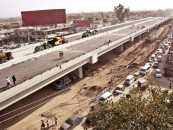Dying Indus
We must come to understand its relationship - between land and life, people and nature.

The River Indus, lifeline of our plains and cradle of our civilisation, is bleeding - and few seem to care. But on Friday, the people of South Punjab made their voices heard. The Sapat Sindhu Salhaar, a Seraiki literary organisation, led a vibrant and symbolic rally demanding protection for the River Indus. Amid the beating of traditional drums and the gentle rhythm of the folk jhumar, poets, writers, students and concerned citizens came together to remind us that the river is our identity and our future.
Today, this mighty river is gasping for breath. Once wild and free, it has been dammed, diverted, drained and, most tragically, neglected. In taming its flow, we have disrupted an entire ecological system. The result is the slow death of aquatic life, shrinking wetlands, and an alarming loss of biodiversity.
For it to heal, we must come to understand its relationship - between land and life, people and nature. What must be done? First, the river's natural flow must be restored. We must ensure environmental flows downstream to keep wetlands and aquatic habitats alive.
Second, pollution must be stopped at the source. Authorities must enforce strict regulations on industrial discharge and invest in modern sewage and wastewater treatment systems. It is unacceptable that a river so vital is used as a dumping ground.
Third, we must empower riverine communities - the farmers, fisherfolk and indigenous populations who live by and depend on the Indus. Their knowledge of the river is unmatched, and they must be included in every conservation effort. We should consider granting the river legal rights - as countries like New Zealand and India have done - so that the Indus can be defended in court and protected from exploitation.
Europe, once obsessed with controlling nature, is now dismantling dams and letting rivers run free again. Pakistan must learn from this.














COMMENTS
Comments are moderated and generally will be posted if they are on-topic and not abusive.
For more information, please see our Comments FAQ